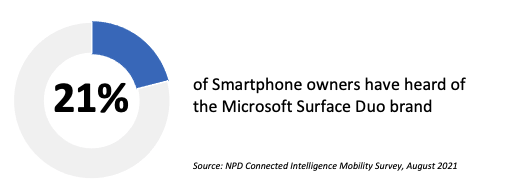
Microsoft unwraps the Surface Duo 2
On September 22, Microsoft’s Surface event brought the announcement of a new Surface Duo 2 with a release date of October 5. This second generation device boasts new features like a new black color, improved triple rear cameras, a glance bar on the side when closed, NFC, a faster processor and 5G support via the Snapdragon 888 5G processor that also powers the Galaxy Z Flip3 and Galaxy Z Fold 3. The Surface Duo 2 will be available starting October 21 with a price tag of $1,499.
The NPD Take:
- A 2-piece foldable might seem less groundbreaking than bendable screens; however, when considering foldable phones, durability is a key concern. In fact, over one quarter of respondents in the August 2021 Connected Intelligence Mobility survey who reported they are not interested in a foldable phone cited one reason as “I don’t think the phone is durable.” The hinged option could encourage some consumers, especially those with productivity in mind, to trust that the screens are more substantial and convert them.
- In the same study, on the same prompt, nearly two-thirds of the disinterested respondents cited cost as a roadblock to foldables. With 5G phones becoming more affordable and even some foldables releasing just below the $1,000 mark, the Duo 2’s premium price point might make it a tough sell. On the other hand, Microsoft has been marketing the Duo 2 for productivity and gaming, with the dual screen and compatibility with the new Surface Slim Pen 2. The specialized marketing could draw in consumers with those specific needs. Nevertheless, carrier subsidy support will be essential to put the upgraded Duo 2 on the map, and so far AT&T, Microsoft’s sole carrier partner for the predecessor Duo, has yet to announce its commitment for the new Duo 2.
T-Mobile Takes on the Rural Broadband Gap
Last week, T-Mobile announced two new initiatives to deliver internet access to rural areas of the US that currently lack broadband access. Starting with 51 new cities across four states (Florida, Georgia, North Carolina, South Carolina), T-Mobile expanded its fixed wireless Home Internet service. With these additions, now people in approximately 600 US locations can log on to T-Mobile’s FWA (Fixed Wireless Access). Competing with cable and telco companies, the carrier hopes to serve the nearly 1 million people across the four states of focus who don’t have access to wired internet providers. The Home Internet for life plans cost $60/month with autopay, but there is a $10 off promotion for a limited time.
In the same vein, T-Mobile is also working with Smart Growth America (SGA) to start up “T-Mobile Hometown Techovers” to build up rural communities. Rural areas can receive grants toward 5G network enhancements, other technology and infrastructure upgrades (such as a makeover of the first town’s Little League field), 100 chances for individuals to win devices and services, and even a free concert. Woodstock, Illinois was first to receive a $200,000 grant, but T-Mobile hopes to use this as another way to help bring the latest technology to more of “Small Town, USA.”
The NPD Take:
- When it comes to trusting a company, consumers are impacted by a several factors. These can include brand name recognition, an impression that the company wants to do the right thing, and the quality of service they think the company provides. T-Mobile’s efforts to do good by extending fixed wireless internet and 5G to previously hard-to-reach geographies could position them well in the first two categories.
- According to the NPD Connected Intelligence Mobility survey fielded August 2021, one quarter of smartphone owners believed T-Mobile has the best 5G coverage of the three postpaid service providers. T-Mobile has an opportunity to grow their reputation as they increase coverage of new areas.


